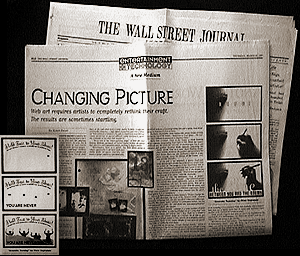The Wall Street Journal
Changing Picture
March 1997
By Robin Frost

[...] "Interactivity is a big part of the Web art equation, often blurring the line between audience and author, artist and viewer. Interactivity is what gives viewers the impression that "the page seems to be alive and it responds to you," says Mr. Squier.
Piotr Szyhalski, a professor of graphic arts at the Minneapolis College of Art and Design who has a Web art site called The Spleen, says that the web artist relies on audience participation to make the work exist. In some cases, authorship becomes a joint project between the artist and the viewer.
For instance, "Amends," part of The Spleen site, is a collection of interactive digital posters. The viewer proceeds through a piece by clicking on elements, which creates a reaction, which cues the viewer to take another action, like clicking or dragging. In "Amends," says Mr. Szyhalski, a viewer's actions "contribute to the piece... so that the action is part of the meaning."
"Amends" presents one piece for each day of the week. In the Tuesday piece, the viewer has to click on a photograph of a left hand to get a photograph of a right hand. Click again, and drag the right hand to "draw" a line down the middle of the frame, a line that separates the two hands. Text is revealed one or two words at a time after each click-related action: "Draw... The Line... Between You and the Enemy." And the music shifts back and forth between a haunting violin line and a quick, loud drumming in response to click actions.
Similarly, the Sunday piece begins with ornate words arching across the top of the frame: "Hold Fast to Your Ideas... No matter what evidence is presented to disprove them."
Each time a viewer clicks in the frame, a small flashing shape appears, progressing from right to left. When the viewer clicks on one, he hears the rat-a-tat of machine-gun fire in the distance and another flashing shape appears, indicating the viewer should click on it next. Each flashing shape, when clicked, produces the gunfire and generates the next shape. each one also produces a word in a sentence running at the bottom of the frame: YOU ARE NEVER WRONG.
At the end of the sequence, a grainy black-and-white photographic image fills in the screen slowly from the bottom up. The image is of four blindfolded men in uniform, standing in a field with their hands in the air; each one's head is placed where one of the shapes the viewer clicked on was located. "Your actions are part of the message of the piece," says Mr. Szyhalski.
There is also the possibility--even in preprogrammed pieces like "Amends"--that different people will explore Web works differently, and so the resulting experience will vary. In some pieces, Web art is changed by a viewer's interaction with the piece, and the next viewer will have a different experience. Some pieces even incorporate feedback from viewers into the piece thus adding to it or changing it. [...]

|